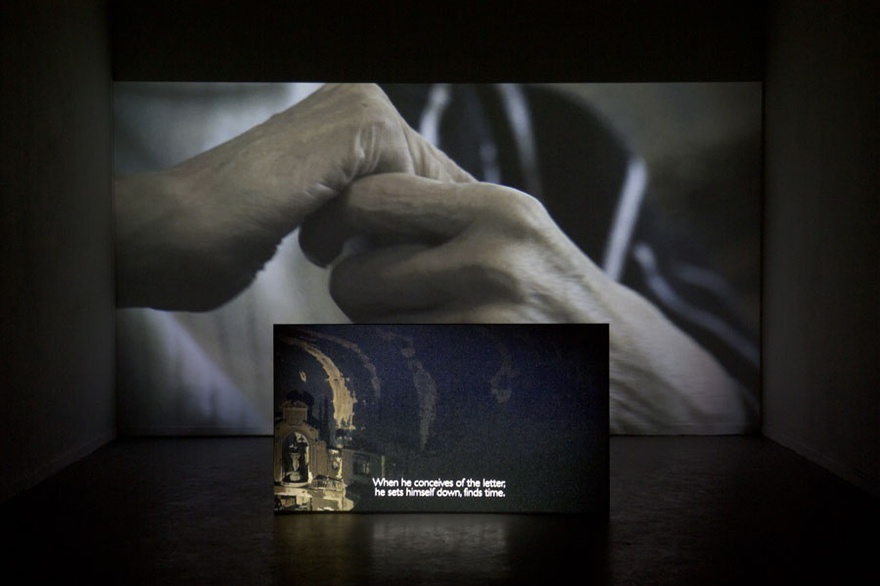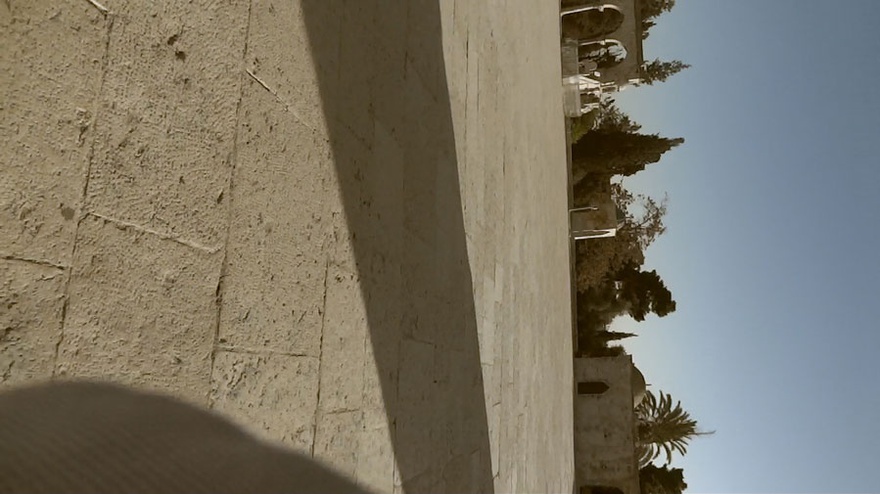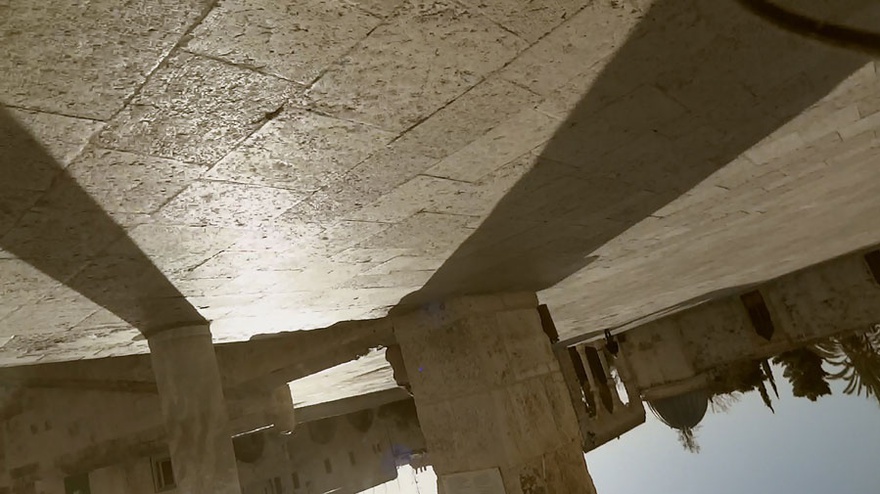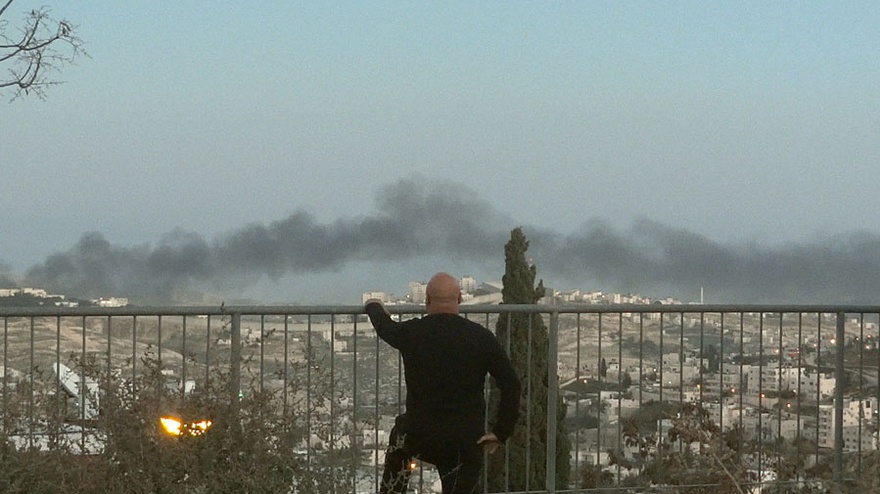Interviews
Shooting What is Missing
Hamza Halloubi in conversation with Natasha Hoare
Hand-held video footage, cinematic panning shots of a dilapidated opera house, cracked whited-out canvases concealing an image beneath, deft vignettes that demonstrate the play of the gaze and our visual preconceptions – the work of Tangiers-born Moroccan artist Hamza Halloubi defies characterization and yet at the heart of it lies a specific vision of place and history, the literatures that have built our relationships to these, and the paradoxical failure and success of image as mediation. What emerges are ambiguous, poetic, open envisionings of the political and personal that seek that which is missing or is non-producible. Working across video, installation and painting, Halloubi's oeuvre has developed across exhibitions and biennales internationally – most recently at the EYE Film Institute, Amsterdam and Du Pont Museum, Tilburg – and through his current residency at the Rijksakademie.
Natasha Hoare: Your work often employs video as a medium, using both immediate hand-held footage and more polished or cinematic documentary style. How does the medium attract you in itself? I feel that rather than draw from its traditions you work more purely through it to question the possibility for representation or an analysis of making an image?
Hamza Halloubi: Lately I've been thinking a lot about video art in general and in my work in particular. I fell into video because I could no longer paint or sculpt and video was enabling me to have new ideas. Today, video art has undergone many changes and is no longer what it was when it was first pioneered. It's as though a different medium has been invented, which in its current use has acquired a new identity. We now make videos of 30 seconds and share them instantly. But what is this thing of 30 seconds, made rapidly and shared automatically? It's a virus that can spread anywhere. Video is the bastard of the arts – it's uncontrollable. Some artists have gone back to film to get rid of this monster and are pretending as though nothing has changed – now techinicuans of video are trying to bring it closer to cinema. The question is not to imitate filmmaking but to make film, or making as though cinema no longer has a reason to exist. I'm interested in this bastard that is video art.
NH: In previous conversations we've discussed your wish to show 'that which is missing'. Can you explain a bit further what you mean by this and what motivates you to re-instate what is missing?
HH: I'm constantly looking for ideas and projects that I am unable to achieve. If one speaks of production in cinema and in art, I'm interested in the non-production. There is often something missing in my work: the untraceable letter Said wrote to his mother in the installation Late (2015), or when I asked to film an Iranian superstar who was certainly uninterested to work with a non-producer! From the onset, I knew I could not achieve this project and this is what, on the contrary, pushes me to continue working. It's also a project about silence, nothingness, the forgotten and what refuses to appear. You know, they're all very easy projects to realize. It's almost no work at all: a trip, a meeting or a few unedited shots and that's it. I don't research or process, it is not the work of a studio or an editing room. It's fluid, it's continuous – again, it's a virus.
NH: The camera, and by extension your gaze, seems to often be employed to create a visual narrative related to site or to a historical figure – such as Jean Genet or Edward Said. Do the narratives generate themselves during your contact with the focus of the pieces? Or do you set out to tell a certain story?
HH: The text, developed from the images that I film, becomes an image itself. I'm not interested in the real because I know that a camera interprets what it records in its own way. And in turn, I interpret what the camera has already interpreted! In videos where I address the intellectual thought of thinkers such as Said or Genet, they are treated as the protagonists of a story. The point of the video installation is not to paint a portrait of these authors, but rather to lead their thought into new territories. To be affected by a thought and in turn to affect something else. This is how a thought grabs your attention and makes you think. It's an arrow shot by someone, which lands somewhere and is then picked up and shot by someone else. But it also depends on the force with which the arrow was shot and where it lands.
NH: The city seems to be an important figure in your work in Tangiers, Jerusalem and Tunis. Indeed, you have been described as a flâneur. How do you relate to this modernist paragon? Are cities more ripe for narrative building than other spaces? What is your attachment to them?
HH: Tangiers is important to me, not only because I was born there, but also because it's located on the fringes of Europe – it's the extreme West in a way. Modernity, and even contemporaneity, make us believe that beyond Paris and New York there is nothing worth discussing. By working in cities such as Tangiers I'm trying to show that there are things happening elsewhere, which defy the centre or relocate it altogether – the global.
I feel like a flâneur who needs a crowd to disappear. I start to plan a trip as an occasion to disappear rather than to appear somewhere. What I film during my travels, which later becomes a work of art, is often the only record I keep. This makes the experience of travelling appear as fiction.
NH: I can imagine that many try to read cultural specificity in your work but, despite your engagement with Genet, its difficult to define you as ostensibly 'Moroccan' or any other sensibility – if such a thing exists. Do you see yourself as dealing with universal concerns? Humanist trajectories?
HH: I do not wish to define myself in terms of one thought, identity or culture. I'm Moroccan and this is neither a fate nor a pleasure. It's a fact. But I'm also European in a way. Jorge Luis Borges described himself as a 'European born in exile'. I like that! Neither Moroccan, African, Arab, Muslim, Amazigh, nor European cultures are alien to me. I do not want to define myself as universal or humanist. I'm certainly lucky to be born and to evolve around all these different cultures, for better or for worse!
NH: Moroccan art has been shown recently in Paris in an exhibition curated by Jean-Hubert Martin, Le Maroc Contemporain (2014–2015). What do you think the value is of these region or nation specific exhibitions?
HH: I did not participate in this exhibition and did not get a chance to see it either. If I ever have the time and opportunity to organize an exhibition with Moroccan artists, I would do it with great pleasure. But for this I would just show 'artists'. I'm sick of seeing exhibitions of Moroccan art with abstract paintings, photographs of veiled women or pseudo-political videos about the situation in Morocco. We are reducing a thousand year old nation with strong imagination and expertise to ridiculous stereotypes that cater to the West or the Moroccan bourgeoisie; it's just unbearable. Morocco has much more creative potential than people think – unfortunately we turn such a rich culture into a grand bazaar and we block its enormous creative potential.
NH: I'm intrigued by your interest in Giorgio Morandi, an artist whose work I've always seen, perhaps wrongly, as being entirely autonomous or apolitical. In your work you draw parallels between his work and the political events of his day, seemingly fundamentally undermining attempts to state that art is autonomous and that it is embedded in its time. Do you read his work as containing traces of these events or does it work to show how outside of these his paintings are?
HH: Certainly, I think the still-life paintings of Morandi capture the historical events of the time and even exceed it. The fact that he continued to make simple still-life paintings with objects of daily-life at this particularly difficult period in history is remarkable. In hindsight, we can see these still-lives as images that survived and defied their own time. To me, the paintings of Morandi are powerful images of what withstands. They are images of what doesn't make noise but which nonetheless continues to exist.
NH: Given you work in video, the concept of time is important – both in terms of the historical excavations of narrative and historical figures (Said, Genet, Morandi), using works that you have made whilst a student, and in terms of the experience of watching the films. Do you seek to undermine a sense of chronological time in your work?
HH: To be honest, I still don't know how to formulate this relationship with time. It's paramount in my work. I'm at the beginning of my career and I'm interested in the late style of certain artists and intellectuals. The late works are a sort of refuge in time; this idea of resistance over time interests me, both in terms of nature and culture. For example, when old and sick Genet joined young revolutionaries it certainly rejuvenated him, but at the same time it put him in conflict with his culture and surroundings. It is an anachronistic approach to time, where the old seems new and the new seems old.
I like the idea of going back and reworking the paintings that I made 12 years ago in Tangiers and to show them today or, as Beckett once wrote, to go back to the artworks to 'fail [them] better'. There are some works that I've reworked several times. To rework the same thing again and again does not only imply working on the thing itself but working on time itself. Yes, I think that time is a material in my work. Each of my videos has its own conception of time. They don't suggest time but, instead, they create their own.
NH: How did your interest in Genet, Morandi and Said emerge? What draws you to these figures? Is it the ripeness of their reinterpretation? Or their contact with the Maghreb?
HH: I became interested in these authors because they each pushed me to think about certain issues such as tardiness, exile, silence in history, the global and the periphery, and the relationship between politics and art. In my video installations the authors are not quite documentary characters; they almost become the protagonists of a narration.
Hamza Halloubi was born in 1982 in Tangier, Morocco. He studied visual art at La Cambre, Brussels and at HISK (Higher Institute for Fine Arts) in Ghent, Belgium. Halloubi's work shows an interest both in the grammar and semiotics of film and language. These rather theoretical fields are then linked to more subjective issues such as memory and translation. Taking personal experience as a point of departure and filtering it through more abstract concepts, Halloubi creates inviting visual metaphors. His films develop an aesthetic that tries to merge the internal poetics of human encounters with a rather conceptual approach. His light boxes and installations investigate language's ability to evoke narratives from fragmented writings. Halloubi lives and works in Amsterdam, Brussels and Tangier.



















